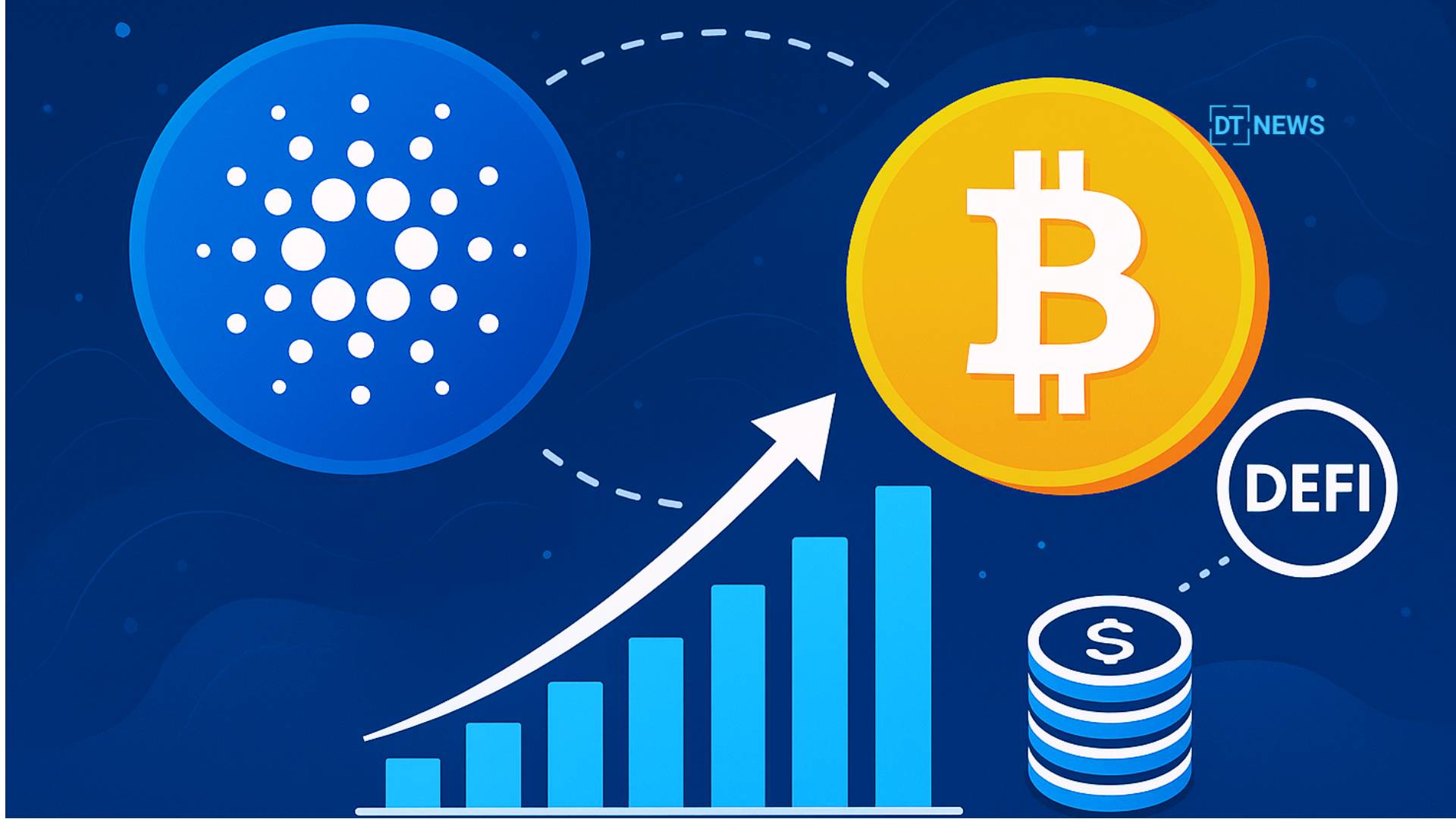Cardano Bitcoin DeFi integration is seen as a major step that could change the future of the blockchain’s struggling decentralized finance network. Cardano has advanced technology and a strong base of loyal users, but its DeFi activity remains limited.
- What Do Cardano, Bitcoin Liquidity, and DeFi Integration Mean?
- Can Better Coordination Shape Cardano’s Next Phase?
- Why Has Cardano Struggled in DeFi So Far?
- How Will Bitcoin Help Revive Cardano’s DeFi Ecosystem?
- Are Stablecoins the Missing Link?
- How Bitcoin Could Drive Cardano’s Next Phase of Growth?
- Conclusion
- Glossary
- Frequently Asked Questions About Cardano Bitcoin DeFi Integration
Founder Charles Hoskinson believes Cardano Bitcoin DeFi integration can help fix this issue. He expects this plan to attract more liquidity and bring lasting growth to the platform.
Something important seems to be developing beneath the surface for Cardano. This change could reshape how the network connects with decentralized finance.
Many in the community believe it could spark new energy within the ecosystem. It may also help Cardano build a stronger and more active DeFi presence in the future.
What Do Cardano, Bitcoin Liquidity, and DeFi Integration Mean?
Cardano is a blockchain platform designed to provide secure and scalable smart contracts. It powers the $ADA token and focuses on governance, sustainability, and interoperability within decentralized finance.
Bitcoin liquidity refers to using Bitcoin’s large capital pool to increase financial activity on Cardano. DeFi integration means linking blockchains like Cardano and Bitcoin so users can lend, trade, or stake assets across both networks.
Can Better Coordination Shape Cardano’s Next Phase?
The Cardano Bitcoin DeFi integration is not just a simple technical connection, but it signifies a new way that Cardano relates to the rest of the crypto world. According to Charles Hoskinson, the main problem of Cardano is its community.He claims that more coordination and better decision making are necessary if there is to be any real progress.
He points out that the problem is in the community structure and the way decisions are taken. The change is intended to create more cooperation among the network members. Charles Hoskinson emphasized that more leadership and unity are the factors that will lead the company to further growth.
Why Has Cardano Struggled in DeFi So Far?
Even with its strong technology, Cardano’s DeFi network is still much smaller than its competitors. Cardano’s overall value locked $271 million is significantly lower when compared to Ethereum’s $85.5 billion and Solana’s $11.29 billion.
The huge difference simply reflects the fact that Cardano is still far from having the same amount of activity as other big blockchains. Many believe the network needs more users and liquidity to close this distance. Experts believe Cardano’s DeFi growth is held back by weak coordination within its community.
While Ethereum and Solana grow quickly through active developer networks, Cardano moves more slowly. Its focus on careful governance often delays new ideas and innovation. This cautious pace has made it harder for Cardano to keep up in the fast-changing DeFi market. Hoskinson believes Cardano cannot grow without stronger leadership and clear accountability.
He said the team is capable of achieving anything but lacks people who take full responsibility for results. This, he explained, is a major weakness within the community’s structure. He added that solving this issue is essential for the Cardano Bitcoin DeFi integration to truly succeed.
How Will Bitcoin Help Revive Cardano’s DeFi Ecosystem?
By linking with Bitcoin, Cardano aims to tap into a larger liquidity pool. The Cardano Bitcoin DeFi integration will let users lend or convert $ADA and $BTC into stablecoins. These assets can then be used in real financial services through the RealFi system.
This plan is designed to bring more value and real world use to the Cardano network. Hoskinson believes this cross-chain model can draw Bitcoin’s large capital base into Cardano’s DeFi system. Rather than relying on short term gains, it focuses on real returns and steady lending growth.
Crypto analyst Darren L. Moore said that if Cardano successfully connects Bitcoin liquidity with its lending system, it could become one of the most significant moves in DeFi. His view supports Hoskinson’s belief that linking with Bitcoin could revive Cardano’s unused liquidity and boost its growth.
Are Stablecoins the Missing Link?
Hoskinson disagreed with the idea that adding big stablecoins like USDT or USDC would quickly boost Cardano’s DeFi growth. He said the network should instead rely on its own native stable assets already available within the ecosystem.
Hoskinson said that simply adding large stablecoins will not solve Cardano’s DeFi challenges. His plan with the Cardano Bitcoin DeFi integration focuses on long term growth by using native liquidity and real world backing instead of depending only on outside assets.
How Bitcoin Could Drive Cardano’s Next Phase of Growth?
Integrating Bitcoin with Cardano is expected to give a strong boost to its DeFi network by bringing in more liquidity and user activity. Hoskinson believes this connection will help attract outside funds and channel them into real financial services like lending and trading.
The plan will let Bitcoin holders use their assets easily within Cardano. If it works, Cardano could become stronger and more competitive in the DeFi market.
Conclusion
The Cardano Bitcoin DeFi integration marks a shift from just building technology to energizing the entire ecosystem. Though $ADA’s price pressure continues, the larger picture tells a story of teamwork, new ideas, and long term strength.
Cardano’s move toward Bitcoin-linked finance is a bold step to show how DeFi can grow when connected with real-world lending. Hoskinson said it is not just about technology but about the people and systems that keep it running.
If successful, the Cardano Bitcoin DeFi integration could unlock the network’s liquidity and boost activity. It could also demonstrate that effective governance and innovation allow Cardano to compete with Ethereum and Solana in DeFi.
Glossary
Cardano: A blockchain that lets people build apps and use the $ADA coin.
Bitcoin Liquidity: How easily Bitcoin can move into or out of markets.
Smart Contracts: Digital deals that run on their own when terms are met.
Blockchain: A shared record of information that no one can change easily.
DeFi: A way to use money and lending on blockchain without banks.
Frequently Asked Questions About Cardano Bitcoin DeFi Integration
Why is Cardano doing this integration?
Cardano is doing this to make its DeFi space more active and attract more users and money with help from Bitcoin.
Who started Cardano Bitcoin DeFi integration idea?
The idea was started by Charles Hoskinson, the founder of Cardano.
What problem does Cardano face in DeFi?
Cardano’s DeFi is slow because there is weak teamwork and fewer people taking part.
How can Bitcoin liquidity help Cardano?
Bitcoin liquidity can bring more money and trading to Cardano, making its DeFi stronger.
What changes are expected after Cardano Bitcoin DeFi integration?
This integration may allow more lending, staking, and trading between Cardano and Bitcoin.



















































































































